![]()
Part 1 -- Denver to Hannibal, December 20 to December 30
Part 3 -- Memphis to New Orleans and Denver, January 4 to January 9

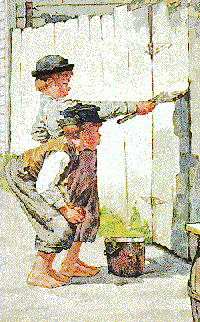
We had a wonderful time in Hannibal. It would be easy to poke fun at the tacky souvenir shops, but the truth is we had a great time. One reason it works is that Mark Twain's characters are loveable, and they are everywhere. Maggie, Tote, and Duncan know Tom, Huck, Becky, and Injun Joe. The kids know parts of Huckleberry Finn and Tom Sawyer from a Garrison Keillor tape and a Wishbone TV show. (The Wishbone show changed "Injun" Joe's name). Also over the last few days, we read the whitewash and pirate episodes as we drove along. Since about a year ago, Maggie and I read Tom Sawyer from cover to cover, Maggie loves to lord her complete knowledge of the book over the boys.
Twain's irreverent personality is also evident everywhere. Twain took a bemused view of the many varieties of human rascality. With Twain looking over one's shoulder, smiling rather than raging at the tourist clutter just seems to be the thing to do.
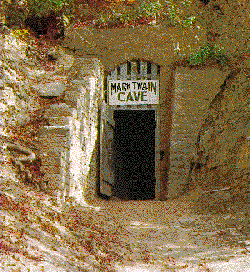 The
kids loved the Mark Twain cave -- the cave in which Becky and Tom were lost
and where Injun Joe ultimately died. Duncan loved it when their guide turned
off the lights. Tote liked the dramatic names, like "Aladdin's Palace." Tote
also liked the "Frozen Waterfall."
The
kids loved the Mark Twain cave -- the cave in which Becky and Tom were lost
and where Injun Joe ultimately died. Duncan loved it when their guide turned
off the lights. Tote liked the dramatic names, like "Aladdin's Palace." Tote
also liked the "Frozen Waterfall."
After leaving Hannibal, we headed for St. Louis. We must be the only folks in the country that don't know that hotels fill up on New Year's Eve. We couldn't find a reasonable place to stay in St. Louis, although we tried, crossing the Missouri River a half dozen times in the process. We ended up staying in Cape Girardeau, Missouri. (We did see St. Louis's Gateway Arch, shimmering unreally, but beautifully, in the darkness.) (Top)
At breakfast, a charming fellow named Bill something wanders over, introduces himself as someone who "does Magic," and gives me an entertaining lecture about various magicians, playing cards, antique trading, the internet, and Cape Girardeau. Bill suggested we visit Trail of Tears State Park, Cape Rock, and Lambert's Café. These were good suggestions.
Cape Girardeau is a walled city. The walls aren't nearly as romantic as those around the fortress of Quebec. These are flat, ugly and made of concrete. They look identical to those that surround most federal prisons. Near the center of town, the walls sport a long mural. Typically, it celebrates famous people from Missouri in the bland style of most public murals. If I recall correctly, this mural contains the visage of that monumental nitwit, Rush Limbaugh. The walls have a couple openings to the River. Large steel doors hang near the gaps in the wall. The riverfront itself is all concrete and rocks. The whole thing is reminiscent of the Berlin Wall. Even the mural has a sort of Soviet feel to it.
|
"Ten thousand River Commissions, with the mines of the world at their back, cannot tame that lawless stream, cannot curb it or confine it, cannot say to it, Go here, or Go there, and make it obey; cannot save a shore that it has sentenced; cannot bar its path with an obstruction which it will not tear down, dance over or laugh at." -- Mark Twain |
Among those who died was Princess Otahki, whose grave is located in the Park. On the day we were there, there were dozens of little handmade crosses decorating the grave.
Near a spectacular view of the Mississippi, some civic-minded group has put up a sign commemorating Marquette and Joliet's 1673 trip down the Mississippi. Marquette and Joliet spent only about a
Camino Real - road connecting St. Louis and New Orleans
Lambert's is the "Only Home of Throwed Rolls" or, as they say in these parts, "thode rolls." Within moments of sitting down, someone is pitching dinner rolls at us. We just about recovered from that, when another Lambert's server stops by the table to ask whether we would like some fried okra. Fortunately they don't pitch the okra at us, but we don't have any plates. A couple grey paper towels from the roll sitting in the middle of the table do the job instead, and we dig in. By the time our dinners arrive, Lambert's has offered us macaroni and tomatoes, fried potatoes and onions, beans, and more rolls. Maggie has also counted over 12 American flags amongst the clutter of license plates, picture, signs, and other stuff that crowds the walls. It is impossible to leave this place hungry or in a bad mood.

From Sikeston we head down to Cairo, Illinois. Cairo is situated at the confluence of the Mississippi and the Ohio. We drive back and forth across the bridges, looking for the spot where the blue Ohio meets the muddy Mississippi. We eventually see a faint line in the water where the waters of these two mighty rivers meet. Pretty interesting.
When Duncan traces the Ohio and its major tributaries on a map, we realize that the Ohio drains an enormous part of the eastern U.S.
and Fort Defiance and Profiteers homes and wall into Cairo
Towosahgy SP
Big Oak Tree SP

Leaving Big Oak Tree, we realize that the shortest way to Memphis is down a tiny State road and across a ferry. We know must have arrived at the ferry site, because the road disappears into an unpaved gravel dropoff overlooking the River. A handwritten sign tells us to "blink Lights for ferry." I do it, but I cannot figure out how the heck I am going to get the van down to the River. Monica and I get out to look around. I can't even find any tire tracks. The only reassuring thing is that the ground is so soft, it looks as if we would end up axle-deep in the muck before we could plunge into the River. While I am figuring out how anyone could possibly get to the River, Monica locates another road on the far side of a little hill. We're not really sure that this road is the right one either, until the ferry pulls in.
The ferry consists of a bargelike affair attached to a small river towboat. The boat is attached to the middle of the barge by a big hinge. Once we are aboard, the ferry backs out a bit, the ferrymen untie the back of the boat, and the boat swings around at the hinge, and we all head off across the river.

As soon as we are settled in our hotel room, Monica rousts us all out for a tour of Beale Street -- a famous spot in the world of Blues. In honor of the place, we have dinner at the Blues City Café. While we eat ribs, tamales, and that old children's menu standby, grilled cheese. This is a great, relaxed place with plenty of interesting people roaming around.
After dinner we ramble up and down Beale Street, listening to the music piped out of the many clubs and restaurants. It's great fun to listen to all of the bands, and we conclude that "our" place -- the Blues City Café -- has the best band by far.
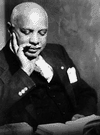
We stop to check out the W.C. Handy statute in the appropriately named W.C. Handy Park. Before we came to Memphis, the only thing I knew about W.C. Handy was that he, along with John Phillip Sousa and 76 trombone players "all came to town on that very same historic day" -- and the only authority I had for that particular fact was the always reliable Professor Harold Hill.
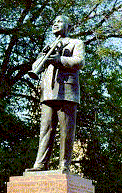
Handy is the "Father of the Blues." For some reason, I thought the blues had always been around. I was wrong. The Encyclopedia Britannica says:
The origins of the blues are poorly documented. Blues developed in the southern United States after the American Civil War. It was influenced by work songs and field hollers, minstrel-show music, ragtime, church music, and the folk and popular music of whites. . . . The earliest references to blues date back to the 1890s and early 1900s. In 1912 black bandleader W.C. Handy's composition "Memphis Blues" was published.
Handy worked during the period of transition from ragtime to jazz. Drawing on the vocal blues melodies of Negro folklore. . . . [h]is work helped develop the conception of the blues as a harmonic framework within which to improvise. With his "Memphis Blues" (1911) and especially his "St. Louis Blues" (1914), he introduced a nostalgic element peculiar to the music of Southern blacks. This was achieved chiefly by use of the "blue" or slightly flattened seventh tone of the scale, which was characteristic of black folk music.
Handy originally wrote the "Memphis Blues" for the 1909 Memphis mayor's race, when one of the candidates engaged Handy to organize bands around Memphis to play for his campaign. Handy wrote it in Pee Wee's Saloon on Beale Street. The candidate went on to win and eventually became one of the most powerful political figures in the South, Boss Ed Crump.
According to George Avakian, Handy's first publisher cheated Handy out of the copyright of the "Memphis Blues":
|
Tim Ransom's Memphis Music Tour (a great collection of information, photos, and music from Memphis musicians) Tim Ransom's W.C. Handy Tour (loads of sound clips and photos from W.C. Handy, including Handy talking about the origin of the Blues) Here are two clips from the W.C. Handy tour: |
After making Handy pay for the printing of the first edition, the publisher claimed that virtually the entire edition of 1,000 copies remained unsold. Faced by this apparent proof of failure, Handy accepted an offer to buy the copyright outright for $50. The publisher, however, had actually printed 2,000 copies, and had sold half of them in Memphis in three days. . . . [T]he publisher promptly ordered 10,000 more copies.
Handy did not reclaim the "Memphis Blues" until the end of the first 28-year copyright term.
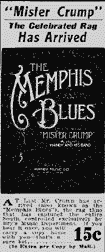
Handy's most famous composition is the "St. Louis Blues." (Bessie Smith sings this excerpt, accompanied by 24-year old Louis Armstrong.) Written in 1914, the "St. Louis Blues" was an even bigger hit than the purloined "Memphis Blues." This time, Handy formed his own publishing company and remained in comfortable circumstances until his death in 1958.
Curiously, neither "Memphis Blues" nor "St. Louis Blues" follows the classic blues form. In fact, some call the "St. Louis Blues" the first written jazz tune. T. Bone Walker says "The 'St. Louis Blues,' That's a pretty tune, and it has kind of a Blusey tone, but that's not the Blues- You can't dress up the Blues!"
Truthfully, I didn't even know there was a particular form for the Blues. I was wrong. According to Britannica, there is a very precise form:
As a musical style the blues are characterized by expressive pitch inflections (blue notes), a three-line textual stanza of the form AAB, and a 12-measure form. Typically the first two and a half measures of each line are devoted to singing, the last measure and a half consisting of an instrumental "break" that repeats, answers, or complements the vocal line. In terms of functional (i.e., traditional European) harmony, the simplest blues harmonic progression is described as follows (I, IV, and V refer respectively to the first or tonic, fourth or subdominant, and fifth or dominant notes of the scale):
Phrase 1 (measures 1-4) I-I-I-I
Phrase 2 (measures 5-8) IV-IV-I-I
Phrase 3 (measures 9-12) V-V-I-I.
The "Memphis Blues" is written in the classic, traditional Blues form of 3 sections and 40 measures, with first and third sections in 12 bar form, a flattened third, and seventh of the Blues scale. Yet when Handy got the original "Mr. Crump Blues" ready for publication as the "Memphis Blues," Handy added the first published jazz break. And, the middle section of the composition consists of 16 measures rather than the traditional 12.
Beale Street has its own police station. The old precinct house is still in use, complete with a desk sergeant flanked by white lamp globes. In this place, visitors are welcome. Over time, the police have collected all sorts of rather odd police-related detritus -- from Machine Gun Kelly's mug shot to an East German policeman's hat.
Beale Street puts all of us in a good mood, including Maggie. In the spirit, Maggie insists we learn one of her songs. The rest of us stand in a circle and sing, while Maggie boogies for all she's worth in the middle.
We're going to Kentucky. We're going to the fair.
To see the little children, with flowers in their hair.
Shake it baby shake it, shake it if you can.
Shake it like a milk shake. Do the best you can.
Rumba to the bottom. Rumba to the top.
Turn around and turn around, until you make a stop.
No one throws money, but we hike off cheerfully to bed, nonetheless. (Top)
 There
are a lot of silly things in Memphis, and this was a day of silly things. It's
hard to top the giant, fake pyramid (Memphis is named after a city on the Nile
-- get it?) adorned with fake Egyptian art or the Graceland phenomenon, but
the ducks were far and away my favorite.
There
are a lot of silly things in Memphis, and this was a day of silly things. It's
hard to top the giant, fake pyramid (Memphis is named after a city on the Nile
-- get it?) adorned with fake Egyptian art or the Graceland phenomenon, but
the ducks were far and away my favorite.

The Peabody is a grand, beautiful, historic hotel. In 1869, Colonel Robert C. Brinkley built the original Peabody, naming it after his good friend and philanthropist George Peabody and bestowed it as a wedding gift on his daughter, Annie Overton Brinkley, when she married a gentleman with the stunning appellation of Robert Bogardus Snowden. The hotel has been renovated or rebuilt several times, but it is hard to imagine it was ever much grander than it is today. The outside is an Italian Renaissance Revival marvel. The lobby is decorated in a rich, luxurious style, with a lovely travertine fountain in the center. The Peabody has hosted Presidents, Confederate Generals, William Faulkner, Charles Lindbergh, and a host of plantation owners, big bands, professional gamblers, and movie stars.
All of this grandeur and glitter is now home to one of the most unusual group of guests any hotel has ever seen. Every day shortly before 11 AM, the magnificent lobby fills up with people. The crowd stands respectfully, four or five deep, around a red carpet that runs from the elevator doors to the base of the base of the marble fountain. Preparing for the appearance of some king or queen? Not exactly.
At 11 AM sharp, grand music plays, the elevator doors open, and out step . . . five ducks. Accompanied by a uniformed attendant, the ducks waddle regally down the carpet and hop into the fountain. There they splash and paddle around until 5 P.M., when the magnificent promenade is reversed. The ducks live in the "lavish Duck Palace" on the Peabody's roof -- the penthouse, so to speak.
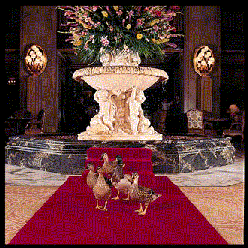
Of course we loved it. Maggie had trouble grasping the whole thing, probably, because it has no rational explanation. "The ducks live here? Inside? Does the Hotel like the ducks? How do the ducks stay here? Do they have beds?" After we tried to explain this to her several times, she grabbed onto one thing that she was certain of and announced, "Those ducks are cute." Since even a five-year old could not come up with such silliness, here's the Peabody's official "explanation":
For all its history and grand tradition, nothing is more symbolic of The Peabody than its world-famous ducks, who spend part of every day swimming in the main lobby fountain. But did you know the tradition started as a joke?
In the 1930s, General Manager Frank Schutt was returning from a weekend hunting trip to Arkansas. Schutt and his friends thought it would be humorous to place some of their live duck decoys (it was legal for hunters to use live decoys) in the Peabody fountain. Three small English call ducks were selected to be the guinea pigs, and the reaction was nothing short of enthusiastic. Since then, Ducks have been in the fountain every day.
In 1940, Bellman Edward Pembroke, formerly a circus animal trainer, volunteered to care for the ducks and taught them to march into the Lobby - initiating the famous "March." The late Mr. Pembroke was named Duckmaster and served in that position until 1991.
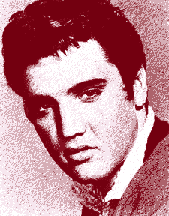
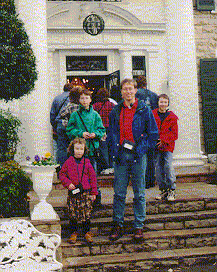 I
confess I didn't expect much from Graceland. Or, more precisely, I expected
a whole bunch of horribly tacky stuff -- the product of someone who was self-indulgent,
drug-crazed, and a bad decorator. And, I expected a bunch of losers oohing and
aahing over how wonderful everything looked. I was wrong.
I
confess I didn't expect much from Graceland. Or, more precisely, I expected
a whole bunch of horribly tacky stuff -- the product of someone who was self-indulgent,
drug-crazed, and a bad decorator. And, I expected a bunch of losers oohing and
aahing over how wonderful everything looked. I was wrong.
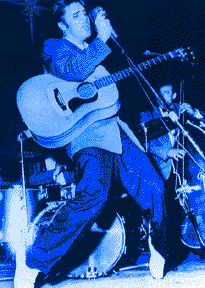
Graceland just isn't very interesting. The place wasn't beautiful, but it wasn't horrible -- particularly when one remembers that Elvis lived (and decorated) here in the 1970's. Even the famed "Jungle Room" didn't shock the conscience. The other visitors seemed interested but not crazed. Stranger folks frequent the Legion Hall in York, Nebraska. Even the new souvenir and restaurant complex that the Presley estate has created to market Graceland and Elvis is not as offensive as many other tourist traps.
The most interesting things about Graceland are its small size and how little emphasis there is on Elvis's place in music. Graceland is large but might not even qualify as a mansion. There are plenty of houses around Denver that are at least as big.
 Nothing at the Graceland complex mentions Elvis's place in music. Though the Graceland tour reiterates how much Elvis loved music, the many awards he won, and his "wonderful" costumes, the Graceland Elvis could be the musical equal of Wayne Newton. The tour focuses on Elvis's lifestyle not his music, and in this officially-sanctioned version of Elvis, that lifestyle seems awfully insipid.
Nothing at the Graceland complex mentions Elvis's place in music. Though the Graceland tour reiterates how much Elvis loved music, the many awards he won, and his "wonderful" costumes, the Graceland Elvis could be the musical equal of Wayne Newton. The tour focuses on Elvis's lifestyle not his music, and in this officially-sanctioned version of Elvis, that lifestyle seems awfully insipid.
By the way, one thing we learned at Graceland: Elvis", "Elvis Presley" and "Graceland" are Registered Trademarks of Elvis Presley Enterprises, Inc. How's that for fun!
|
Tim Ransom's Elvis Presley Historical Tour (lots of photos and sound clips of the early Elvis) includes these two clips: |
Monica found Graceland interesting:
I felt that Elvis as a young man, at the beginning of his career, was a charming, enthusiastic, and charismatic fellow. Over the course of his career, he became hollow. He lost himself to his legend, to his adulating fans.
Early on this trip, Tote took on the role of filling the room's ice bucket at every stop. Until we reached Memphis, he completed this task without trouble. But in Memphis, Tote came face to face with the ghastly "Monster Ice Machine." According to Tote, this behemoth could strike terror into the heart of the strongest ice fetcher: "When you press the button, the ice tumbles out until it fills the bucket, then it spills over to the floor. It only stops after it has overflowed." Despite his daunting opponent, Tote repeatedly succeeded in filling the ice bucket, usually running back to the room laughing. (Top)
Part 3 -- Memphis to New Orleans and Denver, January 4 to January 9